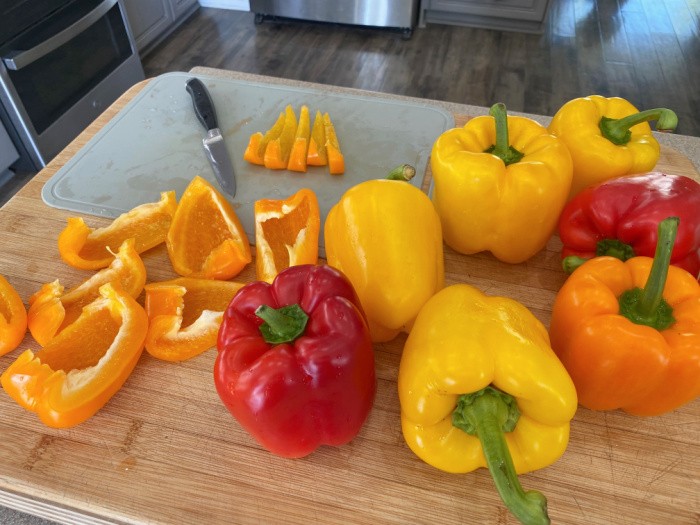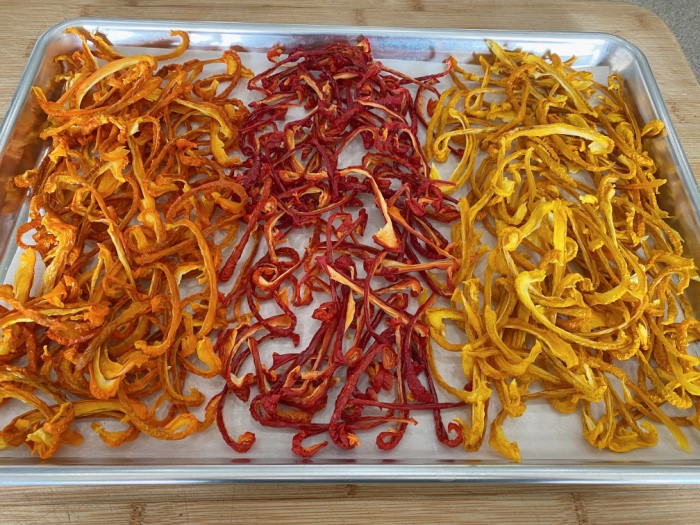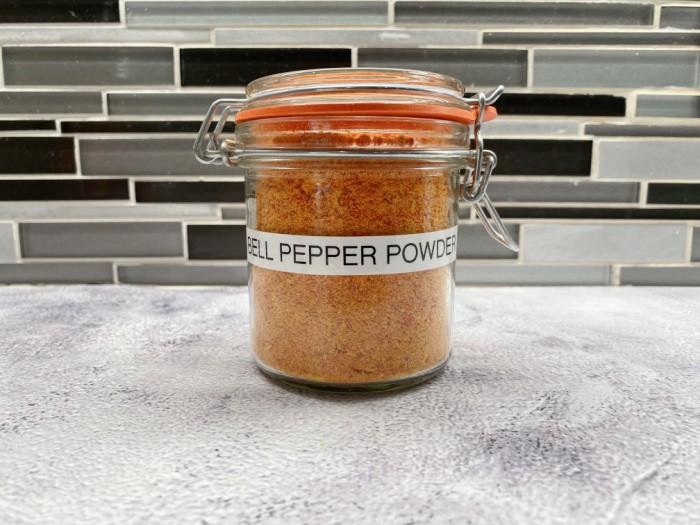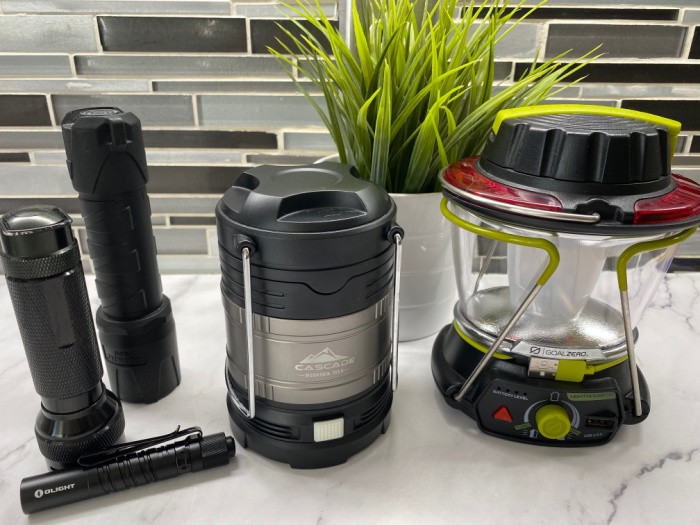How To Dehydrate Bell Peppers
I’ve been wanting to share how to dehydrate bell peppers and make your own paprika powder. I make so many recipes with bell peppers, and I dread going to the grocery store to pick up bell peppers when I just need one or two. I prefer the red, yellow, and orange ones. They seem sweeter to me, so that’s what I purchase.
There are so many dishes you can add some dehydrated peppers to, like soup, fajitas, stews, omelets, quiches, pizzas, sauces, and so much more. My readers know I enjoy sharing ideas about how to grow and preserve foods. With the high cost of groceries these days, it’s a great addition to your family emergency plan when you plant a garden and preserve the foods you harvest.

Kitchen Items You May Need
- Dehydrator (I purchased the Excalibur Dehydrator with a timer)
- A Sharp Knife
- Cutting Boards
- Mason Jars
- FoodSaver with Jar Sealer Attachment
- Funnel
- Small Jars
How To Dehydrate Bell Peppers Instructions
Step One: Wash Your Peppers
Preheat your dehydrator to (125°F) = (51°C) Wash the bell peppers.

Step Two: Start Prepping Them
Remove the stems and cores as well as the ribbing, if desired. You can slice the bell peppers, chop them, or cut them into bite-size pieces.

Step Three: Place Them On the Dehydrator Trays or Racks
The larger the pieces the longer it will take to dehydrate them. It could be anywhere between 10-20 hours, depending on the thickness of the bell peppers, the humidity in the room, and the temperature setting. I didn’t want cubes, so I opted for cutting strips of the bell peppers.

Step Four: Dehydrated
These bell pepper strips took about 20 hours. Luckily, I have a timer on my dehydrator, so I let them dry through the night.

Step Five: Conditioning Your Veggies and Fruits
If you live where it’s HUMID: “To condition the fruit, take the dried fruit that has cooled and pack it loosely in plastic or glass jars. Seal the containers and let them stand for 7 to 10 days. The excess moisture in some pieces will be absorbed by the drier pieces. Shake the jars daily to separate the pieces and check the moisture condensation.” https://nchfp.uga.edu/how/dry/pack_store.html
I used to live in the DRY DESERT: I set my fruit and vegetables on my countertop for 5-7 days. Ten days are even better to make sure everything is dry before using your FoodSaver unit.

Step Six: Use A Blender for Powder
Today I used my Vitamix Blender because it was readily available for use. I have used other types of blenders as well. You’ll “blend” until you get the texture of powder you desire. Some people like there’s course, others prefer fine powder.

Step Seven: Get Ready To Seal
Now, I fill the leftover strips in a quart mason jar and the powder/paprika in these small latch bottles and label them. These are the jars, Small Jars.

Step Eight: Use a FoodSaver
You can vacuum seal your dehydrated peppers in an airtight container when you use mason jars with a FoodSaver and the right jar attachments. I prefer using wide-mouthed jars for all my canning and preserving projects. It makes it so much easier to fill the jars and they take up the same space.

Step Nine: Ready To Store
I use my labeler for everything. This is the one I have Brother P-Touch Label Maker. When you store your dehydrated food mason jars you leave the “rings” on the jars. This is different than wet canning. You remove the rings just in case a lid “pops” up and goes back down, in other words, it’s not really sealed.

Finished Product: Dehydrated Bell Peppers and Powder/Paprika Spice
Here’s the powder or paprika, whatever you want to call it. I wish you were here so you could smell the yumminess from the finely ground dehydrated bell peppers. Yes, the flavor of the bell peppers stays pretty much the same after the dehydration process. It doesn’t affect the calories since you’re just removing the water content. The vitamins stay the same too, which is a real advantage to this approach to preservation.


- 6-18 Bell peppers, I love the yellow, red, and orange peppers the best, they seem sweeter to me.
-
Preheat your dehydrator to (125°F) = (51°C)
-
Wash the bell peppers, and remove the stems and cores. Remove the ribbing if desired.
-
You can slice the bell peppers, chop them, or cut them into bite-size pieces. The larger the pieces the longer it will take to dehydrate them. It could be anywhere between 10-20 hours, depending on the thickness of the bell peppers and the humidity in the room.
-
The time also depends on the humidity of the room you are dehydrating them in and the temperature setting you’re directed to use (your brand) for each type of food product to be dehydrated.
-
Place the sliced bell peppers, bite-size pieces, or chopped pieces onto your dehydrator racks with the screens.
-
The larger the pieces the longer it will take to dehydrate them. It could be anywhere between 10-20 hours, depending on the thickness of the bell peppers and the humidity in the room. I didn't want cubes so I opted for cutting strips of the bell peppers. These took about 20 hours to dehydrate.
-
CONDITIONING: If you live where it’s HUMID: “To condition the fruit, take the dried fruit that has cooled and pack it loosely in plastic or glass jars. Seal the containers and let them stand for 7 to 10 days. The excess moisture in some pieces will be absorbed by the drier pieces. Shake the jars daily to separate the pieces and check the moisture condensation.” https://nchfp.uga.edu/how/dry/pack_store.html
I used to live in the DRY DESERT: I set my fruit and vegetables on my countertop for 5-7 days. Ten days are even better to make sure everything is dry before using your FoodSaver unit.
-
Now, I fill the leftover strips in a quart mason jar and the powder/paprika in these small latch bottles and label them.
-
I used a Vitamix Blender because it was readily available for use. I have used other types of blenders as well. You will blend until you get the texture you desire. Place the powder in an airtight jar. It will store for one year on your pantry shelf.
What is the shelf life of dehydrated peppers?
In my Master Canning Preserving classes we were taught all food dehydrated at home is good for one year, if properly dehydrated. It also helps to store the jars in a cool dark place to lengthen their shelf life.
Do I need to blanch the bell peppers before dehydrating them?
No, you don’t need to blanch them beforehand. My Excalibur Dehydrator book states you can pretreat them, but it’s not necessary. If you want, you can soak them in 1 teaspoon of sodium bisulfite per cup of water as a preparatory step, if desired. I didn’t do that.
Is it better to freeze or dehydrate bell peppers?
I actually do both. I love the convenience of having bell peppers ready at all times to add to soup or stir-fry recipes. If frozen, you don’t have to thaw them out for use, but you may need to adjust the cooking time.
Do you need to remove the seeds before dehydrating them?
I highly recommend removing the seeds. If you planted and harvested the peppers, be sure and save the seeds for next year’s planting.
How do I know when the bell peppers are done?
The time to dehydrate the peppers will depend on the humidity of the room and the size of the pieces you are dehydrating. According to my Excalibur Book, it says to dry at (125°F) = (51°C) until leathery. We may have a different expectation for “leathery” texture, just don’t let them stay too moist or they will go bad sooner.
Can you rehydrate bell peppers?
Yes, you can, add the desired amount of dried peppers to a bowl with boiling water for 30 minutes and drain. If you are making chili, soup, or stews, I just throw some into the pot and the existing liquid rehydrates them.
What is Paprika?
I quote, mcormickscienceinstitute.com, “Paprika is typically made from “bell” or “sweet” type peppers, milder varieties that contain a recessive gene that eliminates (or greatly reduces) capsaicin, the compound responsible for heat. Pepper plants are typically grown from seedlings in a nursery before being transported to the field.”
I haven’t dehydrated hot peppers like cayenne peppers, chili peppers, or other hot peppers. The steps would be the same, just consider the effect those peppers would have when added to any recipe since they will maintain the majority of the hot pepper response with foods.
How can I use my DIY Paprika?
- Omelets
- Roasted Potatoes
- Add to Hummus
- Sprinkle on Deviled Eggs
- Roasted or Fried Chicken
Can I dehydrate these in my oven?
Yes, you can. Set your oven to the lowest temperature your oven settings allow. Place a chunk of foil to keep the oven door ajar. You will need to check them fairly often because they tend to dry very fast.
You can also try air-drying peppers. It’s best to place them in a spot where they can get some direct sunlight. Some people will put them in a netting material bag so the bugs are less likely to get to them.
Other Dehydrating Posts
- Dehydrating Apples
- Dehydrating Bananas
- Dehydrating Blackberries and Powder
- Dehydrating Blueberries and Powder
- Dehydrating Cilantro
- Dehydrating Cucumbers and Powder
- Dehydrating Ginger and Powder
- Dehydrating Grapes
- Dehydrating Green Onions and Powder
- Dehydrating Kale and Kale Powder
- Dehydrating Kiwi
- Dehydrating Lemons and Powder
- Dehydrating Marshmallows
- Dehydrating Peppermint Marshmallows and Powder
- Dehydrating Mushrooms and Mushroom Powder
- Dehydrating Onions and Powder
- Dehydrating Pears
- Dehydrating Pineapple
- Dehydrating Raspberries and Powder
- Dehydrating Spinach and Powder
- Dehydrating Strawberries
- Dehydrating Tomatoes and Powder
- Dehydrating Watermelon
Final Word
Please let me know if you have dehydrated bell peppers, I love to hear from you. Have you freeze-dried some? I love seeing my food storage shelves filled with dehydrated fruits and vegetables. May God Bless this world, Linda























Just a word about storing the dried peppers in plastic. I found when I did it that the plastic took on the smell of the peppers and made it unusable for anything else. This container was one of those fancy ones with the push down lids..Costco, Sam’s, Wal mart. So I switched to glass. Love the paprika idea!
Hi Jeanne, thank you for the 5 starts, my friend! I learned that the hard way as well! The one’s I used were OXO plastic containers. I tried bleach and the smell never went away. I only use glass now! Thank you for the reminder about plastic. Linda
Linda,
Thanks for the tip on making paprika. I’ve never done that, nor have I ever dehydrated bell peppers. I usually just chop, vacuum seal and freeze them.
Hi Ray, thank you for the 5 stars, my friend. I always have some frozen ones in the freezer just in freezer bags, though. If I see a really good buy I will buy several and start slicing. We eat a lot of bell peppers in so many recipes. Linda
I have followed all of your recipes for dehydrating and I just did this one, LOVE IT! Thanks for putting this awesome information out there for everyone to have access to!
Hi Jess, thank you for the 5 stars, my sweet friend! I love dehydrating just about everything!! Love this, Linda
I am going to have to get a dehydrator to make all the goodies you are sharing. All I have is a electric stove.
Hi Jackie, thank you for the 5 stars, my sweet friend. It’s harder here where I’m living to use it often, but when I get into our new small home, it will be running non-stop. You literally will recoup the cost of the machine based on never throwing out any food you can’t eat in the nest fews days. Dehydrate all vegetables and fruits. Linda